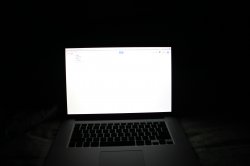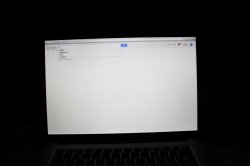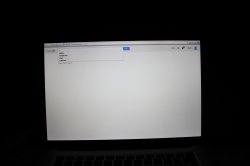Got a tip for us?
Let us know
Become a MacRumors Supporter for $50/year with no ads, ability to filter front page stories, and private forums.
Yellow tint on Haswell rMBP 15"
- Thread starter zOlid
- Start date
- Sort by reaction score
You are using an out of date browser. It may not display this or other websites correctly.
You should upgrade or use an alternative browser.
You should upgrade or use an alternative browser.
Isn't around 80 cd/m2 really dark?
It doesn't work the same way across all displays. 80 cd/m^2 will still look good if the display is optimized for that range. NEC is optimized for something closer to 120ish, although that's too bright for a lot of things. It's just easier to control if you have a low max brightness and dim room for minimal reflections. For photographers, graphic designers, etc, if they have to run inkjet proofs using something like EFI or GMG, most don't own the huge color corrected viewing booths that cost upwards of $8k. Smaller ones are typical. These aren't that bright, so the lower brightness range is suitable. Actual softproofing systems are a bit different. Most of those recommend a very specific set of hardware that has to measure within a certain tolerance. A large viewing booth produces much more returned light reflected off whatever printed media, so their brightness recommendations are much higher.
In all cases it's just about control, and you cannot analyze whether something is bright or dark in an arbitrary manner when describing a completely non-linear representation of raster data on screen. There aren't many specific standards that can be easily applied by independent professionals, so it's easy to pick up what sounds right or not right from fragmented data. All I would really suggest is that if it matches the rest of your pipeline, it is fine, and that too bright a display can be far more misleading visually than one that is darker, assuming it still tracks the appropriate gamma per channel.
Just got my rMBP 15" and noticed a yellow hue on the bottom left corner. Came to MR and found this thread. Seems like a fairly common problem. Trying to "deal with it" but the yellow is quite noticeable on white (such as MR and most other sites).
Couple of questions: Is apple treating this as a known problem or would you have to convince a genius that a problem does exist? And, can Apple Store offer in store replacements (base config + 16 gb ram) for just the screen or will it take time to do a replacement?
Couple of questions: Is apple treating this as a known problem or would you have to convince a genius that a problem does exist? And, can Apple Store offer in store replacements (base config + 16 gb ram) for just the screen or will it take time to do a replacement?
I'm on this issue since the retina came out, there is no solution. Sometimes you'll get better display, sometimes worse.
It's the same story on retina iPads (Air especially).
I came to a point where further replacements etc will not change anything and it's time to enjoy the computer as it is.
It's the same story on retina iPads (Air especially).
I came to a point where further replacements etc will not change anything and it's time to enjoy the computer as it is.
While it is true that IPS displays are more prone to display problems, that's still no excuse for such drastic uniformity disparity across sections of the screen. I had a LSN (Samsung) screen on the original 2012 rMBP and it was damn near perfect.
I'm on my third replacement for my 2012 rMBP now and have a LG screen (previously all Samsung) and they all have some yellow tint or another. This one has the problem of backlight uniformity where the top half is bright and the bottom half is dark and kinda muddy.
To me this is unacceptable and I'm going to get a replacement. Hopefully this next one will turn out all right because I'm getting sick of the constant exchanges (and the weird looks the blind Apple store employees keep giving me). For a $2600 computer to have these problems is simply mind-blowing. This computer is not a $600 dell; it's 4 times the price. I don't expect 4 times the quality. Just a working screen is all I ask for.
I'm on my third replacement for my 2012 rMBP now and have a LG screen (previously all Samsung) and they all have some yellow tint or another. This one has the problem of backlight uniformity where the top half is bright and the bottom half is dark and kinda muddy.
To me this is unacceptable and I'm going to get a replacement. Hopefully this next one will turn out all right because I'm getting sick of the constant exchanges (and the weird looks the blind Apple store employees keep giving me). For a $2600 computer to have these problems is simply mind-blowing. This computer is not a $600 dell; it's 4 times the price. I don't expect 4 times the quality. Just a working screen is all I ask for.
Just got a 15 N exchange for my R samsung
...And how is it?
...And how is it?
Best black screen test I've run yet.
Looks like it's a samsung too. What a surprise.
Not yellow. I guess it only takes 8 Machines to find a good one.
U cant check if its LG or samsung?
i have a N LG and screen is pretty dope too!
It is a samsung. LSN
Tonight is officially my last exchange. It is a Samsung model N. The salesperson from Apple was very understanding, But he was also firm. He asked me... After 3 exchanges, Where do you want to take this? I then opened the box in the store. Apple customer service is by far the best in the business. Don't let anyone tell you otherwise
Last edited:
Hello, I am new!!!
I just took pictures of mine. (Canon 18 MP DSLR)
One at full, one at 50% and one at lowest.
How do they look?
By the way, I love the MBP retina Haswell. It's soooo fast!!
I just took pictures of mine. (Canon 18 MP DSLR)
One at full, one at 50% and one at lowest.
How do they look?
By the way, I love the MBP retina Haswell. It's soooo fast!!
Attachments
Sorry, what do you mean by R and N?
@tears apart
woah so u have a R?
mine is a N and i think its pretty decent but i will send next week some pictures of my screen black n white to have members opinion.
its my first mac so i cant really tell since my old lappy was a sony
how do you find in MAVERIKS what brand is your display panel ??
type in terminal:
ioreg -lw0 | grep "EDID" | sed "/[^<]*</s///" | xxd -p -r | strings -6
LSN - samsung
LP - LG
Hello, I am new!!!
I just took pictures of mine. (Canon 18 MP DSLR)
One at full, one at 50% and one at lowest.
How do they look?
By the way, I love the MBP retina Haswell. It's soooo fast!!
I am by no means an expert, but I think your screen is fine. If the one I ordered turns out like yours, I will be happy.
for me it doesnt...i press enter and nothing happens..no error or something
forgot to mention, you have to use sudo before that command, so it can be run as an administrator. You have to enter your password after that and it should be fine.
sudo = SuperUser DO
I wonder if it is safe to say that R has finally gotten rid of most of the kinks since there appear to be fewer people complaining about this issue, save for one.
My R stunk
It's December and I want to order again. How are the new batches? (After 2 replacement I asked for a refund. It was getting silly. I wish the only issue I had was yellow uneven screen, but i had hardware problems too) Any improvement or still the same problems like months ago?
Register on MacRumors! This sidebar will go away, and you'll see fewer ads.




